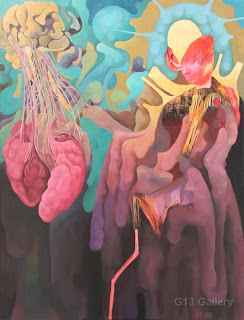Transfiguration @ G13
Transfiguration is defined as "a change of form/appearance into a more beautiful or spiritual state". This notion seems contradictory at first sight in Haslin Ismail's solo exhibition, where the viewer is subjected to skeletal shapes and bulbous forms. Focusing on the acts of drawing and painting in this collection, the artist displays a maturity in both subject matter and technique, departing further from the comic book fantasies that first garnered recognition. Grotesque forms are retained, together with a colouring effect that take after a nebulous yet luminous quality.
 |
| Transfiguration (2013) |
A close examination of human body parts like bone and muscle, are apparent in paintings such as ‘Qalbu’ and ‘Contemplation’. The former with its black background sets off to expose what lies underneath the skin; The latter utilising a self-absorbing black hole that anchors the large picture in the centre. Illustrations of a machine-made man and the delirious depiction of ‘Ecstasy’, portray a strong sense of dystopia that culminates in ‘Transfiguration’. Two giant beings wrestle for man’s attention, one covered in lumpy bark and another with a metropolis crown, their respective posturing inspired by Japanese anime.
 |
| Queen (2013) |
‘Dorsiventrality’ number amongst Haslin’s best work, where signature shapes and expert shading coalesce, to narrate the duality of life via an insect’s carcass. ‘Queen’ features a bug-eyed character, its collage pulling the strings of a pink brain, drawing attention away from an amazing dripping effect below the red paper cut-out. These cerebral works indicate a deeper exploration of serious subjects, moving beyond even the classical theme of ‘Death’. Projecting a surreal commentary about modernity and religion, the overlaying objects in ‘Consecration’ resemble a submission to the artist's subconscious train of thought.
 |
| Dorsiventrality (2013) |
Haslin’s sinuous drawings of fantasy characters and landscapes are always visually captivating, where he seems most potent at vertical structures, especially in ‘Resah Qalbu’ and ‘Hatred’. Kudos to the gallery for an informative catalogue, that includes a brief by local art collector Bingley Sim and many pictures of the artist’s drawings in the past. Rachel Jena contributed an essay that mentions the use of jute, a decision that allowed Haslin to achieve a better painterly effect as compared to canvas. Haslin Ismail, as Rachel puts it, “...has transfigured [...] like the very characters that you see in his art today".
 |
| Resah Qalbu (2012) |
Comments
Post a Comment